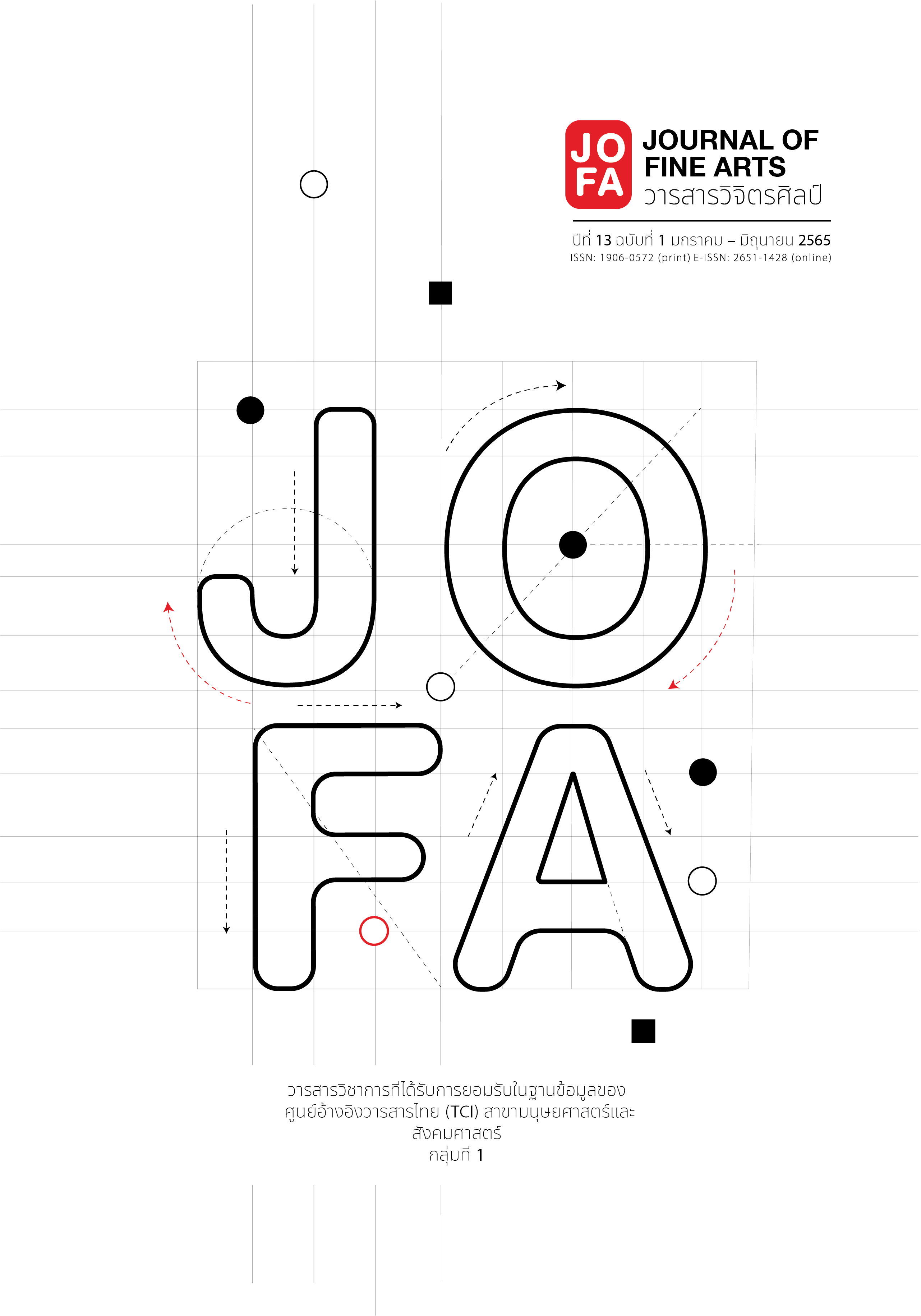The Empathy Building in Design Student through the Community Activity
Main Article Content
Abstract
Empathy is an important quality of the designer because it leads to better acquiring information and understanding the problems and circumstances of users and stakeholders of the design works, and delivering the designs that truly solves problems. Besides, for the practice of design in class assignments, the out-of-curricular activities could be an alternative way to improve empathy in the design students. This study uses the interview with the university students participating the Vernacular Art and Culture Voluntary Activity by the Faculty of Architecture, Kasetsart University. An interview has shown the results that the activity could be able to create empathy from their parts of the conversations including the realization of the situations that each community is facing with, and the emotional expressions toward the situations, which could confirm that the volunteers have empathy within themselves. The study has demonstrated that the community activity can be used and developed as a method to create empathy in the design students.
Article Details

This work is licensed under a Creative Commons Attribution-NonCommercial-NoDerivatives 4.0 International License.
References
Battarbee, K. Co-experience: understanding user experiences in interaction. Finland: Aalto University, 2004.
Brown, T. Change by design: how design thinking transforms organizations and inspires innovation. New York, USA: Harper Business, 2009.
Boonprakob, M. “Phǣnphūm Manō That Kap Kānsāng Sœ̄m Su Čhi Pu Li. [Conceptual Mapping for the enhancing skill of Listening, Thinking, Questioning and Recording].” Journal of Graduate research 3, no. 3 (2000): 47 - 55.
Coleman, R., Lebbon, C. and Myerson, J. “Design and empathy.” In Inclusive Design: Design for the Whole Population. London: Springer, 2003: 478-499.
Cross, N. “Here comes everyman.” The proceeding of The Design Research Society Conference, (1971): 11 - 14.
_______. “Designerly ways of knowing: Design discipline versus design science.” Design issues 17, no. 3 (2001): 49 - 55.
Chantavanich, S. Withīkān Wičhai Chœ̄ng Khunnaphāp. [Qualitative Research Methodology]. Bangkok: Chulalongkorn University, 2006.
Chuawanlee, W. Kānphatthanā Satipanyā Thāng ʻĀrom Phư̄a Khwāmsamret Nai Kānthamngān. [The Development of Emotional Intelligence for Successful in Work]. In the Collection of E.Q. Academic Articles. Sukharom, A., Chuawanlee, W. and Choochom, O, eds. Bangkok: DESKTOP, 2000: 171 - 175.
Denton, H., and McDonagh, D. “Using focus group methods to improve students’ design project research in schools: Drawing parallels from action research at undergraduate level.” International Journal of Technology and Design Education 13, no. 2 (2003): 129 - 144.
Dorothy, L., and Rayport, F. J. “Spark innovation through empathic design.” Harvard business review 75, (1997): 102-115.
Design Council. “Eleven lessons: managing design in eleven global companies. Desk research report.” Design Council. Accessed April 19, 2020. http://www.designcouncil.org.uk.
Ickes, W. Empathic accuracy. New York: Guilford, 1997.
Kemmis, S. and McTaggart, R. The Action Research Planner. 3rd ed. Geelong: Deakin University Press, 1988.
Kowtrakul, S. Čhittawitthayā Kānsưksā. [Education Psychology]. Bangkok: Chulalongkorn University Press. 1998.
Kolb, D. Experiential learning: Experience as the source of learning and development. New Jersey: Prentice-Hall, 1984.
Koskinen, I. “Empathic design in methodic terms.” In Empathic Design-User experience in product design. Finland: IT , 2003.
Krasae-in, A., and Trairatwong, N. “Kānrīanrū Chœ̄ng Prasopkān Phư̄a Kānsưksā Dān KānʻŌ̜kbǣp Kō̜ranī Sưksā Khrōngkān ʻŌ̜k Bǣp Samrap Kānthō̜ngthīeo Chumchon Talāt ʻIng Nam Sām Khōk. [The Experiential Education in the Design Field: The Case Study of the Design for Tourism in Sam-Kok Market].” The proceeding of 10th Phuket Rajabhat University Academic Conference, (2017): 196-202.
Luck, R. “Dialogue in participatory design.” Design studies 24, no. 6 (2003): 523-535.
Mancharoen, P. “Phon Khō̜ng Kānchai Kitčhakam Phatthanā Khwām Rūam Rūsưk Læ Kānchai Tūa Bǣp Sanyalak Thī Mī Tō̜ Phrưttikam ʻƯ̄afư̄a Khō̜ng Nakrīan Chan Prathomsưksā Pī Thī Hā. [Effects of using activities for developing empathy and symbolic models on altruistic behavior of prathom suksa five students].” Master’s thesis, Faculty of Education, Chulalongkorn University, 2001.
McDonagh, D., Thomas, J., and Strickfaden, M. “Empathic Design Research: Moving Towards a New Mode of Industrial Design Education.” Design Principles & Practice: An International Journal 5, No. 4 (2011): 301-314.
New, S., and Kimbell, L. “Chimps, designers, consultants and empathy: a “theory of mind” for service design.” The proceeding of 2nd Cambridge Academic Design Management Conference, (2013): 4-5.
Pruitt, J., and Adlin. The persona lifecycle: keeping people in mind throughout product design. San Fransisco: Elsevier, 2005.
Sanders, E. “Converging perspectives: product development research for the 1990s.” Design management journal 3, no. 4 (1992): 49 - 54.
Squires, S., and Byrne, B. Creating breakthrough ideas: The collaboration of anthropologists and designers in the product development industry. Westport: Bergin and Garvey, 2002.
Strickfaden, M., Devlieger, P. and Heylighen, A. “Building empathy through dialogue.” The proceeding of Design Connexity: 8th International Conference of the European Academy of Design Conference, Gray’s School of Art, The Robert Gordon University; Aberdeen Scotland UK. (2009): 448 - 452.
Tangnatee, W. “Khrōngkān Prapprung Phūm That Chumchon Talāt ʻIng Nam Sām Khōk Phư̄a Kānthǭngthīeo Chœ̄ng Watthanatham ʻAmphœ̄ Sām Khōk Čhangwat Pathum Thānī. [The Landscape Design of Ing Nam Sam Khok Community for Cultural Tourism in Sam Khok District, Pathum Thani Province].” Research report, Faculty of Architecture, Kasetsart University, 2018.
Sleeswijik Visser, F., Van der Lugt, R., and Stappers, P. J. “Sharing user experiences in the product innovation process: Participatory design needs participatory communication.” Creativity and innovation management 16, no. 1 (2007): 35 - 45.
Wannapo, W. “Phonkānchai Kitčhakam Fưk Khwāmrūsưk Wai Thī Mī Tō̜ Kān Rūam Rū Sưk Khō̜ng Dek Wai Rœ̄m Run. [The effect of sensitivity training towards preadolescents’ empathy].” Master’s thesis, Master of Education Program in Developmental Psychology, Srinakarintarawirot University, 2002.
Wong-in, N. “Kānphatthanā ʻĀrom. [Emotion Development].” In the Collection of E.Q. Academic Articles. Sukharom, A., Chuawanlee, W. and Choochom, O, eds. Bangkok: DESKTOP, 2000: 136 - 143.


